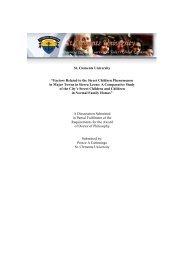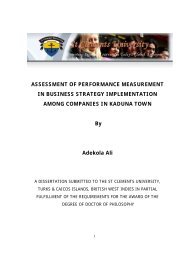Rufus Folorunso Akinyooye - St Clements University
Rufus Folorunso Akinyooye - St Clements University
Rufus Folorunso Akinyooye - St Clements University
Create successful ePaper yourself
Turn your PDF publications into a flip-book with our unique Google optimized e-Paper software.
to close its gold window was unilateral and the run on gold that preceded the announcement<br />
did not allow many banks to protect themselves. Because the Bretton Woods exchange rate<br />
agreement was a universal one, its breakdown threw the entire economies of the world into<br />
what was once the exclusive preserve of developed economies i.e. the printing and circulation<br />
of fiat money. After the collapse of the Bretton Woods exchange agreement the first bank to<br />
fail was Herstatt Bank in Germany in June 1974. The failure of this bank, which was the<br />
largest, and the most spectacular failure in German banking history since 1945 (BCBS 2004)<br />
was attributed directly to the collapse of the Bretton Woods exchange accord. The bank had<br />
speculated on the foreign exchange market, which became riskier under the post Bretton<br />
Woods free-floating currencies system. The bank’s failure reverberated throughout the world<br />
as banks exposed to Herstatt suffered losses at the end of the day that its licence was<br />
withdrawn giving rise to what became known as the “Hersatt risk” in the financial world’s<br />
parlance (ibid).<br />
To the rescue came the 1974 inflow of petrodollars to the oil producing nations of Middle East<br />
and Latin American countries and their outflows to the banks in G10 countries. The increase in<br />
fuel bill impoverished non-oil producing underdeveloped economies and they had to look for<br />
funds to meet up. On the other hand banks in G10 countries were awash with loanable<br />
petrodollars from oil producing countries and glee fully they lent to the hungry non-oil<br />
producing countries, which were under puppet dictatorial, and corrupt regimes favoured by<br />
the United <strong>St</strong>ates for their anti-communist postures. It is noteworthy that at this time most of<br />
the G10 countries had put in place some sort of insurance over deposits in their commercial<br />
banks patterned after the Federal Deposit Insurance Corporation (FDIC) in the United <strong>St</strong>ates<br />
established by the Banking Act of 1933. Where a separate body did not exist, the country’s<br />
Central Bank stood by the banks, which would be lending through the International Monetary<br />
Fund (IMF) anyway. These lending G10 banks, which came to be known as “internationally<br />
active banks”, lend as a consortium through the IMF, which would on-lend to be the lenders to<br />
the third world countries having balance of payment deficits because of the oil crisis.<br />
(<strong>St</strong>ambuli11998). It follows that any default would reverberate throughout the countries of<br />
lending banks.<br />
As less developed countries borrowed short term to service their debts through G10 banks<br />
their debts grew by leaps and bounds because they must not default. Mexico was the first to<br />
throw in the towel in 1982 by announcing on September 6 of that year the postponement of all<br />
debt payments until the end of 1983. This was a potential crisis for internationally active<br />
banks, which had lent Mexico huge sums over the previous eight years. Within the<br />
international financial system several banks had lent to Latin American countries considerably<br />
more than their total capital. In 1982, claims of selected U.S. banks on 4 major Latin American<br />
debtors namely Mexico, Brazil, Venezuela, and Argentina were US $176billion. The eight<br />
largest banks in the U.S.namely Citicorp, Manufacturers Hannover, Bankers Trust, Bank<br />
America, J. P. Morgan, First Chicago Chase Manhattan and Chemical were owed US$37 billion<br />
on that amount representing 147% of their capital and Reserves. If other countries were to<br />
follow suit, a number of internationally active banks would have collapsed or forced to be<br />
rescued at enormous cost to their countries taxpayers. Since half of the debts of less developed<br />
countries originated from non-U.S. banks, the debt crisis became international. Memories of<br />
the Great Depression of the 1930s loomed large (Lutz 2000). Once again the banks had over<br />
lent and were faced with defaults. The IMF had to come up with subsidies, debt re-scheduling
















